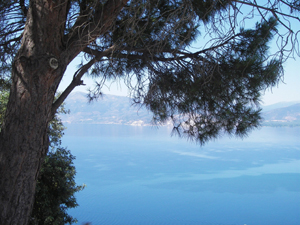|
|
|
From Malta to Turkey |
|
|
The water splashing against the boat was full of phosphorescence. It was my watch and the regular rhythm of the engine sounded safe and comforting as I sat in the dark (blissfully unaware of what was to come). I moved carefully, so as not to wake Mike who was asleep. We hade decided that no matter what the weather was like, we would be hooked on by the lifeline. It would be a nightmare to wake up and find that the other person was not there anymore. You sleep better that way. After checking the screen on the chart plotter/radar, I found that everything was OK. No boats within several miles and we were keeping to our course. I sat down again and enjoyed the spectacular scenery around me. The water was glistening beautifully and the moon was rising above the horizon like a big ball of fire. Many a time I have been astonished by how quickly both the moon and the sun appear and disappear. The sky was covered with stars and planets. How many of the constellations did I recognize? Not as many as I would have liked to. Soon the moon was high up in the sky and the surroundings were basking in a silver white glow. While I was observing the sky and hoping for a shooting star, I realized my own insignificance in what we call the cosmos. I also felt humble and grateful for the opportunity of experiencing all this. Yes, I saw some shooting stars as white streaks across the sky, but what I didn’t count on seeing was a meteorite coming down at great speed, as I thought, very near. A gold coloured ball of fire tumbled down fast and went out, not far from the boat at all. That’s how it felt anyway. Quite fantastic! The hours passed quickly and my watch at 02.00 – 06.00 ended with a spectacular sunrise before I woke Mike up.
This night was experienced on the Ionian Sea on our way to Greece. After I had slept and was sitting on my next watch, we had this little visitor come to see us. He/she was resting on our boat at position 37o 39,20´N and 17o 57,03´E. Without any fear it peeped into the boat, hopped around a bit and was then on its’ way again.
|
|
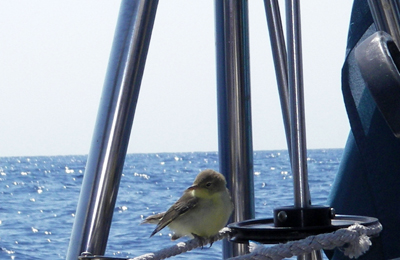 |
|
|
Before we got this far we left Malta on the 1st May and got to Sicily, where we start our story this time. |
|
|
Syracusa/Sicily |
|
|
The crossing from Malta to Porto Palo, the first stop in Sicily, went without any problems. We were swinging on the anchor over the night and carried on towards Syracusa the next day. We rounded Castello Maniace (1293) which is situated furthest out on the Isola d’Ortigia, to get to the marina. We stayed only one night here as it was more like a building site than anything else. We did take the opportunity of visiting an Internet Café and have a little stroll around the town.
|
 |
|
For us Swedes Syracusa is known as the home town of St. Lucia. Most saints have their own special days, as has St. Lucia in Syracusa. It is the 3rd May. Our own “Queen of Lights” has her special day on December 13th. We decided to pass up on these festivities this time.
|
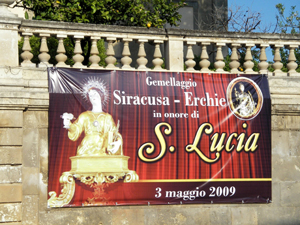 |
|
Amongst all the palaces, fountains and historical buildings we saw this piece of art. It is called “The awakening” and the artists surname was Johansson. This piece was created for the G8 summit of the Environmental ministers, which had just closed before we got there. The ministers have indeed a lot to discuss. Not least the pollution of the seas and all the plastic floating about.
|
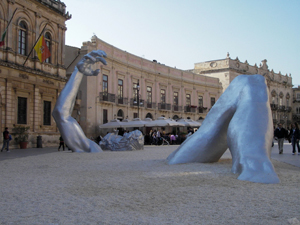 |
|
We moved out into the bay and anchored amongst our neighbours from Malta. Several boats had made their way here and were waiting to get away to various places. It was nice to see each other again. Here we have Sören and Eivor on Apostrof weighing anchor on their way north towards Catania. We decided to go straight across the Ionian Sea to Argostoli on Cephalonia.
|
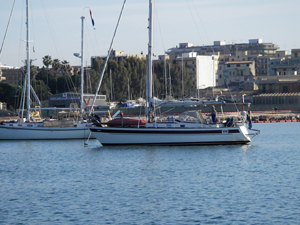 |
|
Cephalonia/Greece |
|
|
It was time to change our courtesy flag and this time it was the Greek one being hoisted up the halyard. This was the morning of the 7th May and the sun hadn’t yet warmed the air. It was really cold in the night. The passage from Syracusa to Cephalonia took 2 ½ days and was calm, but full of experiences (see above).
|
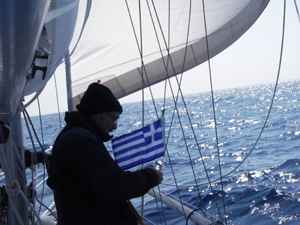 |
|
Cephalonia is part of the Ionian Islands which consists of Corfu, Paxi, Lefkada, Cephalonia, Ithaca, Zakynthos and Kythira. Geographically Kythira is not an Ionian island but is counted as one because of its’ joint history.
|
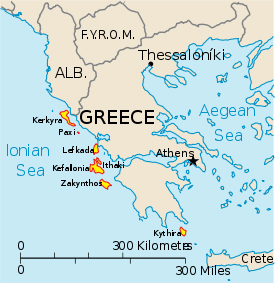 |
|
Our first impression was of the green hills and the scent of wild herbs wafting towards us. We looked forward to mooring and getting a closer look and see what the Greek culture had to offer.
|
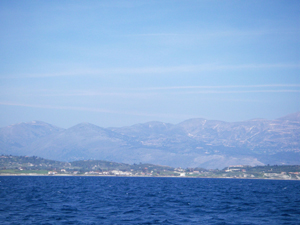 |
|
Argostoli |
|
|
This building is actually a lighthouse which was situated on the promontory we had to get round to get to Argostoli, the capital of Cephalonia. Later we found out that the British had built it during their time on the island.
|
 |
|
We moored along the town quay in Argostoli and noted how clean and well looked after it all looked. We walked to the Port Authorities not far away. There we found out that we had to go to the tax office to pay our taxes to be ale to travel in Greek waters. Then we had to go back to get our documents stamped. This way we got our first tour around the town before we found the tax office.
|
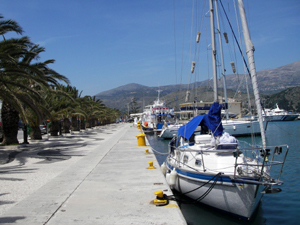 |
|
There was water along the quay, but no electricity. The first notable experience was the price difference for staying compared to the rest of Europe. €3/day. It was unbelievable.
|
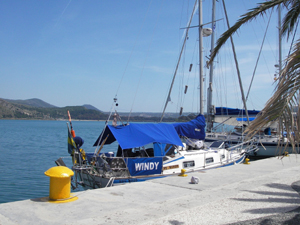 |
|
It was overwhelming how green everything was! Trees, bushes and flowers everywhere. The Ionian islands are known for being the green part of Greece. During our 12 day stay in Argostoli we walked a lot. The coast was very beautiful… Here a few pictures.
|
 |
 |
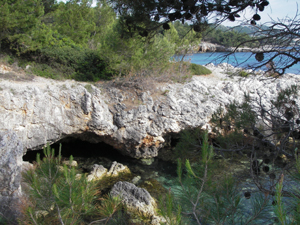 |
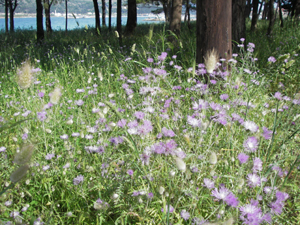 |
 |
|
The town itself looked very new and clean and we soon realized why. It is only 56 years old. The reason being the big earth quake, which destroyed most of the island on the 12th August 1953. The buildings have been rebuilt in an earthquake proof fashion.
|
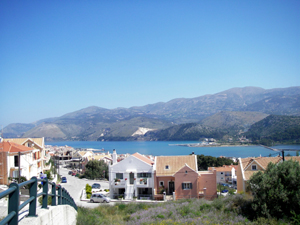 |
|
The fault line between Europe and Africa passes through the middle of the Mediterranean from Gibraltar, between Sicily and the foot of Italy, along the Greek west coast, over Crete towards the Middle East. There it meets the Arabian plateau. Another fault line goes from Levkas to the Dardanelles over the northern part of Greece. This means that most of the earth quakes in the Mediterranean take place in this area. Luckily we haven’t experienced any during our stay.
|
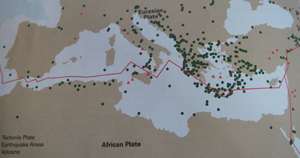 |
|
This monument at the Drapani bridge was erected by the British to show the greatness of the British Empire. When the British left in 1864 the commemorative plaque disappeared. During WW II the Germans used the monument as target practice.
|
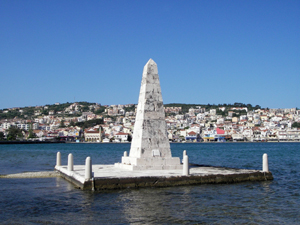 |
|
On the other side of the Drapani bridge a bird sanctuary has been created. A beautiful walkway meanders around the reservation with good information about the bird life. You can also find the big turtle Careta Careta here.
|
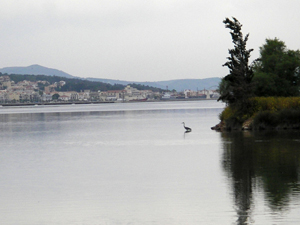 |
|
One day we caught the bus over the mountains to the other side of the island to Sami, where the Melissani cave is just 2 km out of town. There is a lake in this cave 39 m deep. The cave itself is 160m long and 40m wide.
|
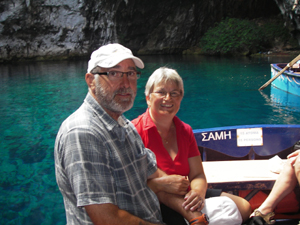 |
|
The stalactites are dated to be about 16 000-20 000 years old. Artifacts from 3-400 B.C. have been found, indicating a cult worshipping the god Pan.
|
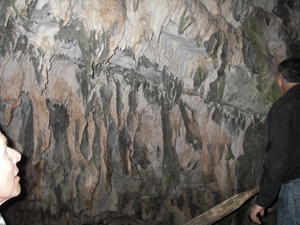 |
|
A suggestion: Check the bus time table to find out when the bus goes back. When we were to take the bus back to Argostoli at 15.30 we were told that the next one would leave at 23.30. We negotiated a good price with a taxi driver…
|
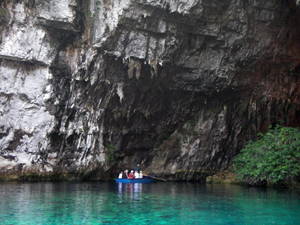 |
|
Before we left Malta we took our down pillows to the launderette together with our sheets and duvet covers. A little luxurious, but nonetheless. We got the pillows back as loose feathers in two carrier bags! One pillow had split and the staff had been picking feathers for hours! Our sheets and covers were neatly folded and smelt nice and fresh. When we changed sheets in Argostoli and shook them out with a flick there were feathers everywhere! It was the launderette staff’s revenge… Duct tape is good for a lot of things…
|
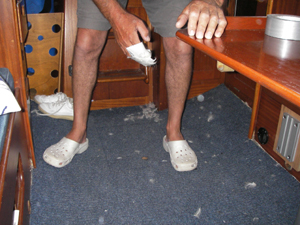 |
|
As you have probably noticed I am interested in all kinds of plants. This is an Araucria Heterophylla. It was discovered during James Cook’s second trip, on which Linné’s protégé Anders Sparrman took part, that this tree was discovered on the Norfolk Island in the south western part of the Pacific. It is a popular tree to be planted in gardens throughout the Mediterranean. The information about plants I get from a Swedish book called “Plants from warm countries” by Åke Sandhall and Ulf Swenson. A fantastic book.
|
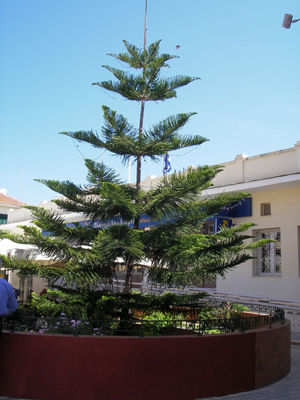 |
|
On a walk to the “Italian Monument” we met this lady who was picking wild thyme, which grew in abundance along the road.
|
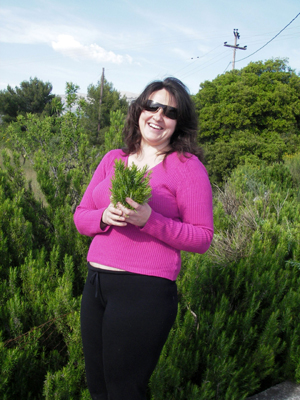 |
|
The history is, as it is in the whole of the Mediterranean, varied. During ancient times the Ionian Islands were sought after by Sparta, Athens and Corinth, but as the rest of Greece, fell into the hands of the Romans in 146 B.C. They since belonged to the Byzantines, Turks and the Venetians up to 1797 when the French took over. 1798 – 1807 the islands were occupied by Russia before the French took over again. 1814 the islands fell into British rule. 1863 the islands were passed over to the Greeks. 1941 Greece was occupied by the Axis powers and the islands were handed over to the Italians. The Germans occupied the islands from 1943 to 1944 when the resistant movement EAM/ELAS controlled the power.
|
 |
|
A large number of Italian soldiers died/were massacred whilst fighting the Germans. This monument was erected in honour of their memory.
|
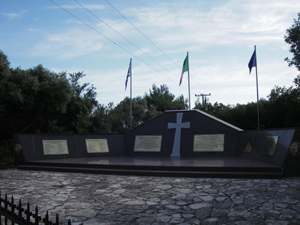 |
|
While we were in Cephalonia I read “Captain Corelli’s Mandolin” by Louis de Bernier. The story takes place in Cephalonia and I recommend it with pleasure.
|
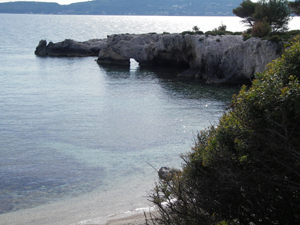 |
|
Even if we were charmed by Argostoli and its’ surroundings it was time to carry on with our travels. |
|
|
Fiskardo |
|
|
Fiskardo is a picturesque village and is one of the few places spared during the earthquake of 1953. The main means of support today is tourism and this harbour is home to three different charter boat companies. The turnover of crews is huge and boats are in and out all the time. You learn how to deal with fouled anchors very quickly here! For us it is an advantage to have a small boat – there is always space somewhere. There was no charge to moor here.
|
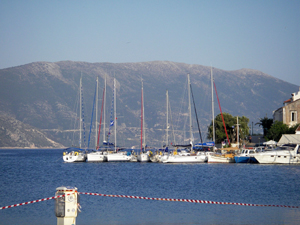 |
|
After a couple of days we carried on and had got out to the sound between Cephalonia and Ithaca. Then all the alarm bells started ringing! There was no wind whatsoever so we were motoring, but now we switched the engine off quick as lightning. In no time at all, the engine temperature had rocketed and was sky high. So there we were – bobbing along. What to do now? Well, we had met a very nice English couple in Argostoli, Peter and Gussie Toft, who were now in Fiskardo and who’s telephone number we had. We called them and they came out to rescue us.
|
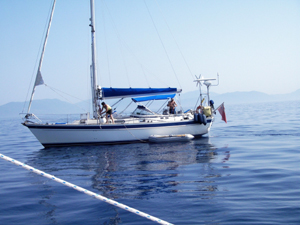 |
|
As we got back into port friendly people helped us moor. It didn’t take that long to find out what the problem was. It was the fresh water pump for the cooling system that had broken down. The chandler was very helpful and after many phone calls and clarifications the new pump arrived from Athens. The kind of pump we had wasn’t manufactured anymore, but luckily the new one fitted nicely. This took four days. Meanwhile we were taking it easy and enjoying life…
|
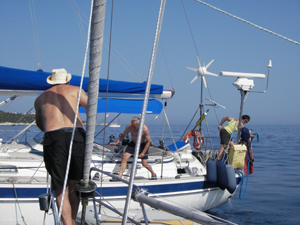 |
|
Nothing more can happen to the engine now…. can it? |
|
|
Ithaca |
|
|
Ithaca is known as the birth place of Odysseus. Homer’s ballad about Odysseus’ journey home from the war in Troy is well worth reading. “The cave of the Nymphs”, where he supposedly hid his treasures when he came home, is a big tourist attraction today. We chose not to go ashore and explore this island, but anchored in Dexia Bay near Vathi.
|
 |
|
We anchored and Mike rode a line ashore which we tied on the stern. This was the first time we moored this way and it worked very well. We felt safe when the afternoon breeze came howling.
|
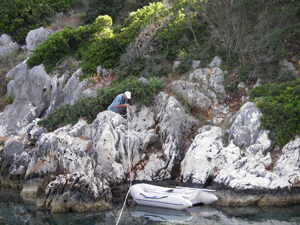 |
|
The country side is very green and on the other side of the bay we saw olive groves growing.
|
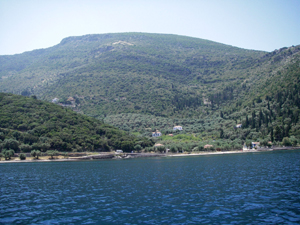 |
|
We admired the vegetation, whilst sitting in our cockpit. It was varied and the olive trees made the display complete. In the evening we heard the goat bells tinkle as the goats moved in the undergrowth.
|
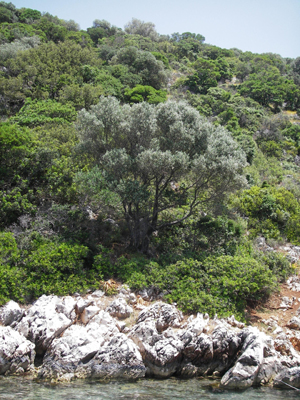 |
|
Lefkada |
|
|
Our English friends John and Amber, whom we met last year, were now at Vassiliki, so we decided to make our way there. Lefkada, or Lefkas as many call it, is situated close to the mainland and can be reached from Preveza, which has an airport. There are many nice beaches and tavernas to visit on the island and the charter boat season is very intensive. We haven’t seen so many Swedish flags in the Mediterranean as here! |
|
|
It was nice to meet up again and to celebrate our reunion we went out to a restaurant for a tasty meal. We decided to try out the Greek beer “Mythos”. Not bad at all.
|
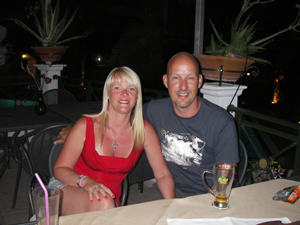 |
|
Later in the evening we joined a group of wind surfers and a sailing school who had organized entertainment and dancing. So, we let rip on the dance floor with: ”Ooooooh, leeeets twist again! Like we did last summeeeer! Ooooh….” Great fun! We walked home in the early hours of the morning to the ”cock” crowing… Isn’t it strange that after such a nice evening you would think “never again! ” ???
|
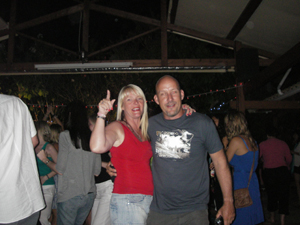 |
|
The Vassiliki bay is beautiful with high mountains on one side of it. In the mornings there is no wind at all, but in the afternoon the wind howls down the mountainside and wind speeds can reach up to Bft8 (17-20m/s). The bay is very popular with wind surfers as there is a guaranteed wind in the afternoons.
|
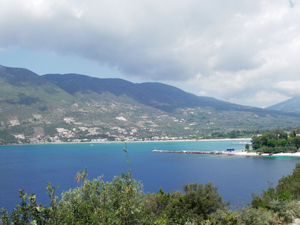 |
|
As we sailed from Ithaca, and even here in Vassiliki, we saw yellow butterflies everywhere. At long last we caught one with the camera…
|
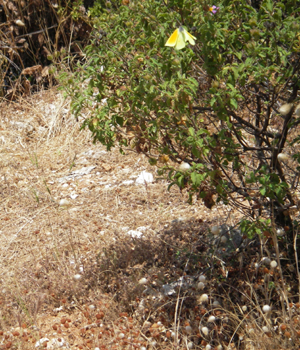 |
|
We also had a thunderstorm with rain while we were here…
|
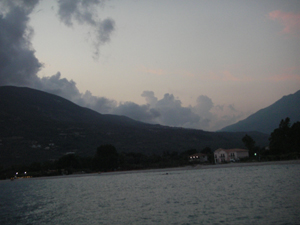 |
|
Nidri |
|
|
John and Amber gave us good suggestions about where to go next. We decided on Nidri and Vlikho Bay. It was really nice and quiet here. We anchored and stayed for a week reading books. And went swimming and really enjoying ourselves. The book I read was called “Shantaram” containing about 1000 pages and well worth reading. We have read a lot of books and I am not going to mention them all. The two I have mentioned are the ones that felt most outstanding this summer.
|
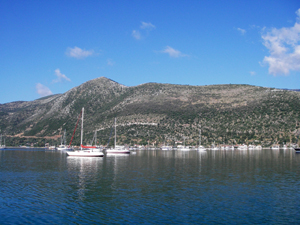 |
|
After a stop over at Lefkada town, where we stocked up with food and necessities, we went back to Vlikho Bay and explored the town of Nidri. We moored at a charter pontoon, where most of the boats were out, and had access to electricity, water and a swimming pool, if you wished, for €10/nights. "Chip" the dog was saved from drowning by an English couple. |
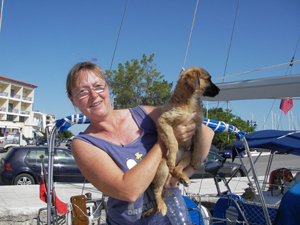 |
|
We were told that outside the town there would be a waterfall and, of course, we wanted to see it. We followed the signs informing us that it was 3km away. After walking for about 20 minutes we saw another sign: “Waterfall 3km”. We carried on. We reached the path to the fall after trekking for 1 ½ hours. |
|
|
On our way up we saw a beautifully flowering plant. After checking in my book I concluded that it must be a species of Bougainvillea Spectabilis, i.e. big triplet flower. It is called a triplet flower because of it having three large colorful “crown leaves” (don’t know the exact English translation - sorry). The actual flower consists of three small white flowers in the middle. The plant comes originally form the tropical Brazil and it was Louis Antoine Bouganville (1729-1811), French seafarer and explorer, who found the species during a round- the-world trip.
|
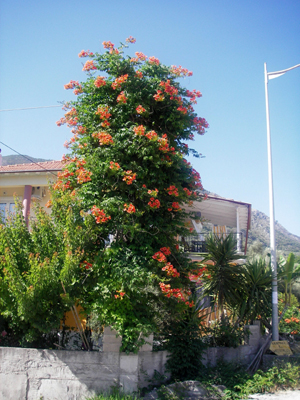 |
|
The path meandered through beautiful gorges with lovely countryside.
|
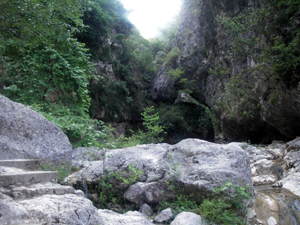 |
|
We had almost reached the falls when we were stopped by a tape crossing the path. The path was closed just for the day and would re-open tomorrow. Sigh. We took a picture of this little one instead.
|
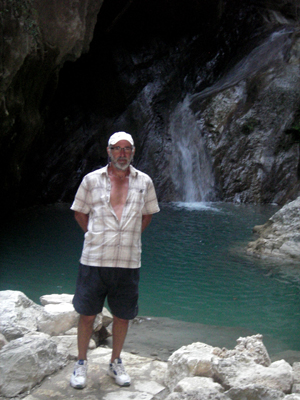 |
|
On our way down Mike took his shoes and socks off and cooled his feet in the water. When we saw our daughter Sarah last, she asked us: “Why do you always take pictures of Dad’s feel?” Well, that’s a good question.
|
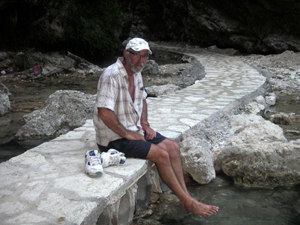 |
|
It took us a fair while to make our way down and when we reached the town we went to a restaurant and ordered a nice pizza. Tired but well pleased.
Here in Nidri we met up with Sören and Eivor on Apostrof again. Also Thomas and Eva with their boat. Very nice.
|
 |
|
Towards the Corinth Canal |
|
|
The plan now was to slowly but surely move towards the Corinth Canal, with a few stops on the way. The weather was glorious, but not a lot of wind. The iron sail was very useful.. When we at long last got some wind, we were still motoring to charge our batteries. Quite frustrating. |
|
|
Elia Beach, Meganisi |
|
|
Meganisi is an island with many creeks and bays where one can anchor. You can also find the so called “Midsummer Bay” there, where many Swedes celebrate Midsummer. We chose not to go there, but anchored by the Elia Beach. Quiet and peaceful with not many boats there. Up on the hill there was a village where we bought supplies.
|
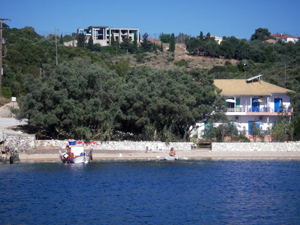
|
|
This volcano was opposite our anchorage, but unfortunately I have been unable to find out what it is called. Nevertheless, it is beautiful.
|
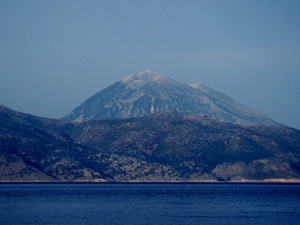 |
|
The landscape was very dramatic with lots of mountains.
|
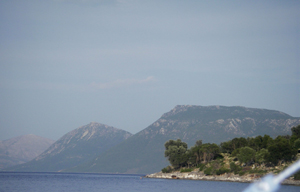 |
|
Astakos |
|
|
We followed the mainland coast to Astakos. Unfortunately there wasn’t any place for us on the quay, so we anchored in the bay outside. The picture is taken later when we were topping up with water.
|
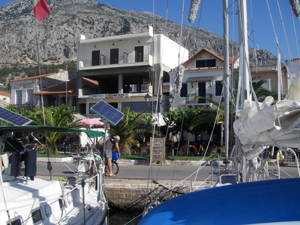 |
|
Before we got that far things happened. After swinging at anchor for two nights we were ready to carry on. No wind about so we intended to start the engine. As Mike turns the key I normally check the fresh water cooling system, so that it works. We didn’t get that far. There was a terrible screeching noise and sparks were flying around the engine and I shouted to Mike to turn the engine off. NOW WHAT COULD IT BE NOW???? We tried again – same thing happened again. |
|
|
We thought that it had to be the starter motor. We dismantled it and took the dinghy into town. After a run-around to the chandler, a garage and lastly an electrician we got the problem sorted out. |
|
|
We were told to wait by the garage after the mechanic had made a phone call. We wondered what we were waiting for. It turned out to be the electrician who turned up on a motorbike. “Something wrong with your starter motor? Yes. Where is your boat? Out in the bay. Show me – jump up!” So Mike could do nothing but jump up onto the bike and off they went. I was left holding the starter motor. After a while they were back and Mike did look a bit pale around the gills with his knees around his ears. “Go and have a cup of coffee and come to my workshop in half an hour” So that is what we did. During the motorcycle ride the electrician had shown Mike where his workshop was, so we went there. “Nothing wrong with the starter motor”, he told us. He was now coming to the boat to install it. It turned out that the problem was a short in the electrical system and not a serious one. Now we wondered how much all this was going to cost and we couldn’t grumble at the price of €10. We established that we have to improve our trouble shooting methods…
|
|
|
Nothing more can happen to the engine now…. can it? |
|
|
|
|
|
Akra Aspro |
|
|
We were now on our way to a nice anchorage south of Astakos called Akra Aspro and got there without any problems. We met up with our good friends Dave and Lindsay on Rosa di Venti. It was really nice to see them again. They had their son Rob staying with them, who is a professional chef, and we were invited to a real gourmet meal in the evening. As we had different plans for the summer, we went our separate ways in the morning, but decided to meet up again next year.
|
 |
|
Misolongi |
|
|
We only stayed one day in Misolongi where it was time to stock up again. The marina is under construction and the future plans look promising. Hopefully the marina will be finished in the near future. |
|
|
Navpaktos |
|
|
Before we got to Navpaktos we went under the Rios bridge connecting the mainland with the Peloponnese. A majestic sight. We had to contact the radio tower about where and when we could go under the bridge.
|
 |
|
There were also forts either side of it.
|
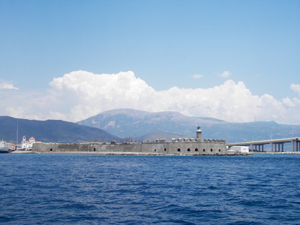 |
|
Navpaktos is not far away and you can see the bridge like a monument to modern architecture in the background.
|
 |
|
There is a Venetian castle up on the hill with a view over the whole bay. This place was very strategic as all the shipping had to go through this little sound. The history tells you this if nothing else.
|
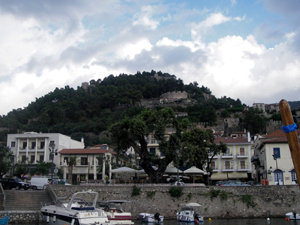 |
|
The Venetians also built the two towers at the entrance of the little harbour. A big chain was stretched between them as ships were looking for sanctuary.
|
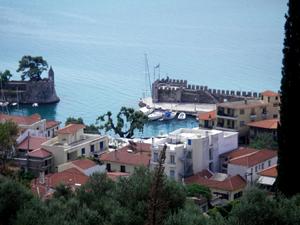 |
|
This monument is not about the Olympic fire, but depicts a Greek who torched Turkish ships in the harbour.
|
 |
|
We liked Navpaktos, but the young night life was a bit too much for us, so we only stayed for two nights. |
|
|
Itea/Delphi |
|
|
The leg from Navpaktos to Itea took seven hours and was a glorious sailing experience! It is, after all, a sailing boat that we have. As we planned to go to Delphi, we chose Itea as the nearest harbour. The harbour was big and half finished. In principal it was only a mooring along a concrete quay. In hindsight it would have been better to go to Galaxidhi. |
|
|
We took the early bus up to Delphi. Mike sits and waits for the bus.
|
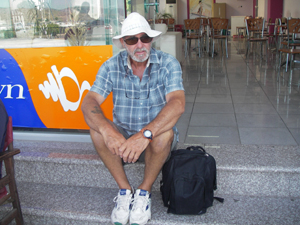 |
|
We got a nice panorama picture of the olive groves down to Itea from Delphi.
|
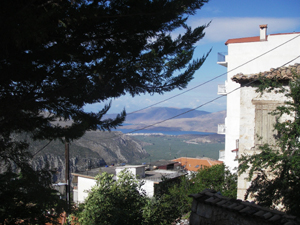 |
|
According to old mythology the God Zeus wanted to find out where the middle of the earth/world was. The method he used to find out was to release two eagles – one to the east and one to the west. They met in Delphi and landed on a stone, the knave of the earth, and this way showed where the middle of the earth was. In this way the ancient Greeks wanted to emphasize the importance of Delphi, not just for the Greeks, but for the whole world. Today Delphi is the holiest and most respected archeological sites in Greece. “Omphalos” cut out of marble symbolizes the middle of the earth and was placed in front of Apollo’s Temple .It is now preserved in the museum. Well worth a visit.
|
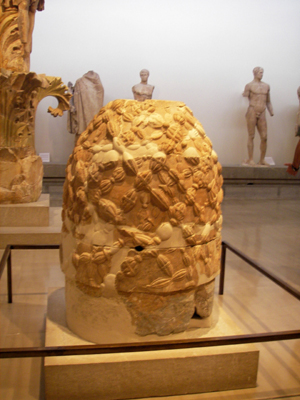 |
|
It is also said that everything started with mysterious fumes emitting from the fissures which gave the site a holy character. The sanctuary of Apollo got walls surrounding it and was filled with monuments, statues and small temples. An amphitheatre was built where the Oracle or the High Priestess, in an intoxicated state from the fumes, answered questions about religion, politics and even moral questions. Here the amphitheatre with Apollo’s Temple in the background.
|
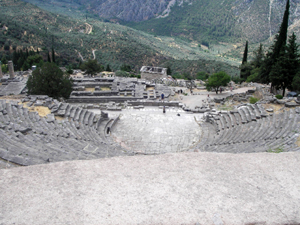 |
|
The pillars are still majestically standing tall.
|
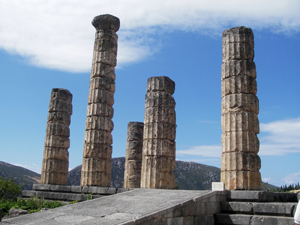 |
|
In the company of an English family we met on the bus, we toured the ruins of Delphi. Here a picture of Peter and Kay Bartlett and Kay’s sister Ann. Thank you for nice company and a lot of information.
|
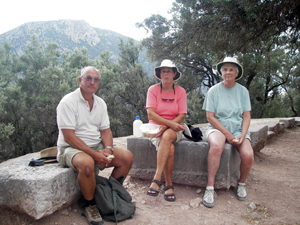 |
|
The history of Delphi is interesting and it is easy to get engrossed in it. It has been established that there existed human activity in Delphi at 4 000 – 3 000 B.C. The discovery of an organized dwelling place dated 1300 -1100 B.C. has proved that a female deity existed in the area.
|
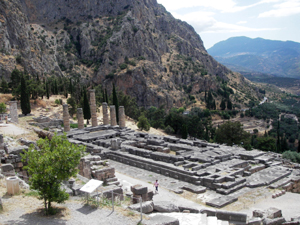 |
|
Delphi is situated 700m above sea level with a fantastic view.
|
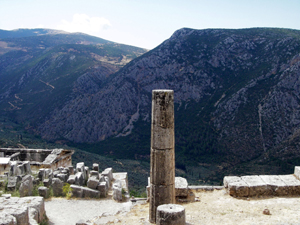 |
|
As we know, earthquakes are quite common in the area and Peter told us that walls were built in this fashion to withstand them. We can state that they are still standing.
|
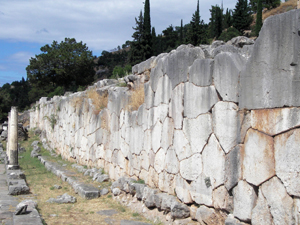 |
|
Couldn’t resist taking a picture of this “wigbush” or Cotinus Coggygria. This is what I think it is. Very nice.
|
 |
|
They spent a lot of time on sports and here is a gymnasium where they used to train.
|
 |
|
Then they competed at the Stadium. |
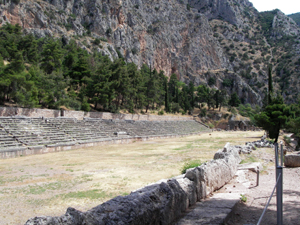 |
|
The holy road and in the background the Treasury.
|
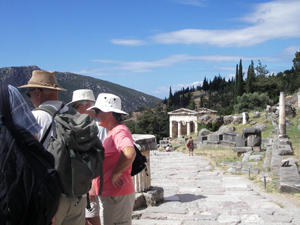 |
|
You can see remnants from different periods of time in the walls, like here with a terracotta pattern integrated.
|
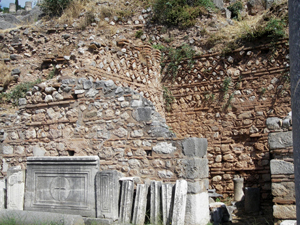 |
|
Here the round temple of Athina.
|
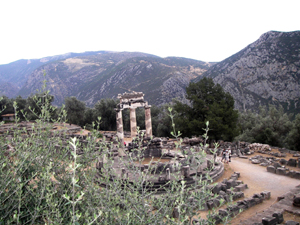 |
|
Took a picture of flowering Capers. |
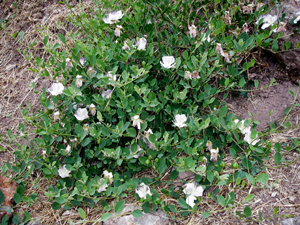 |
|
On 570 B.C. the Naxians donated this Sphinx to the Sanctuary of Apollo. Well preserved in the museum.
|
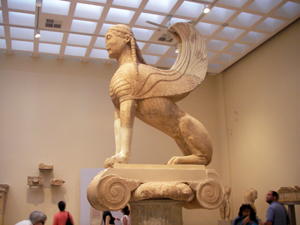 |
|
On the way to the bus stop we saw these goats having a break. Olive groves in the valley below.
|
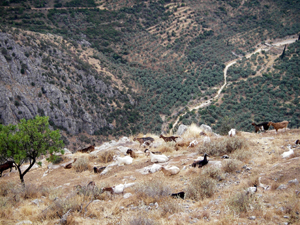 |
|
Galaxidhi |
|
|
It took us 25 minutes to move to Galaxidhi, but what a difference. Angelo helped us to moor and there was electricity and water on the quay. Angelo also gave us an internet code. We stayed four nights here.
|
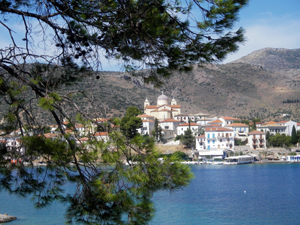 |
|
|
|
|
On our walk around a peninsula we found this statue. The inscription said: “International memorial to the wife of the seafarer was commissioned by the maritime community in recognition of her unique contribution to the cause of family, shipping and mankind. 20 September 2008 “
|
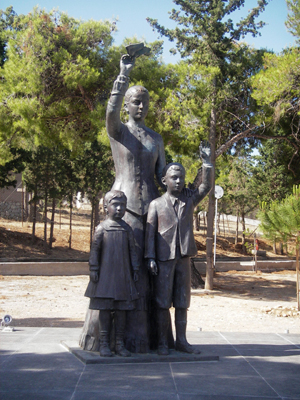 |
|
This beautifully flowering bush is growing wild. You can also find it planted in parks, etc. It is called Oliander Nerium Oliander. Already 1500 B.C. this plant was used as a motif for wall paintings in Crete and later in Pompei. The plant is also used for medicinal purposes and is very poisonous. One leaf is a deadly dose and death occurs within 24 hours.
|
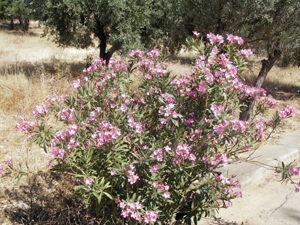 |
|
Later when we walked in the village we saw the Captain…
|
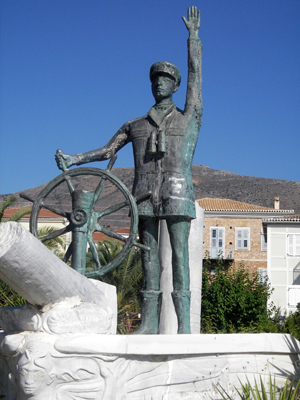 |
|
We bumped into Peter and Gussie Toft again here in Galaxidhi. It is nice to meet up again and hear all the stories since the last time. |
|
|
Alkionidhes |
|
|
Alkionidhes is a group of islands not far from the Corinth Canal. We stayed only one night. It is a nice anchorage with crystal clear water. The only disadvantage – if you think it a disadvantage – was that it seemed to be a bird colony. The noise level was rather high…
|
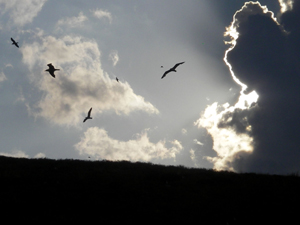 |
|
|
|
|
The Corinth Canal |
|
|
We did another stop before the canal and it was Kiato, where we stayed the night. We left early the next morning for the canal passage. The canal opens at regular intervals to let traffic through its’ one way system. We missed an opening by minutes and had to wait about an hour for our turn. It surprised us that there were no good places to moor whilst waiting. Before we went in we were asked about our maximal speed.
|
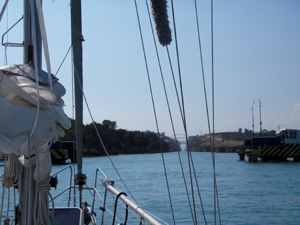 |
|
Since ancient times the Peloponnese has been invaded by different tribes crossing the isthmus. The Corinthians were the first people to have the idea of digging a canal, but never did it. They invented and built a slipway, diolkos, where they dragged the ships across the isthmus. Different powers ruled over a long period of time. But 67 B.C. Nero started to dig the isthmus and succeeded in digging a huge trench before he died and the work stopped. The canal became a reality in 1891 – 1893.
|
 |
|
“Windy, Windy get up to your maximum speed!” Our engine was going flat out and couldn’t go any faster, which we calmly informed the control tower. |
|
|
It surprised us that they urged us to go faster and that there were no speed limits in the canal. We saw how the sides had eroded and big chunks had fallen into the water.
|
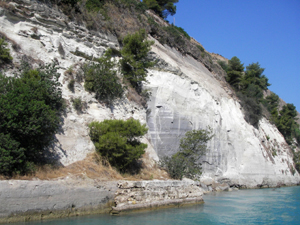 |
|
As we went under the bridges we recognized the site from all the pictures we had seen.
|
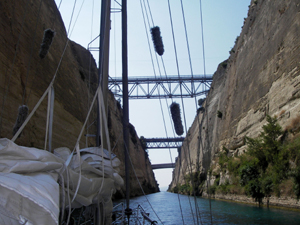 |
|
When we emerged on the other side we had to pay the fee of €103 for our boat. |
|
|
Peloponnesus |
|
|
On the way to our first stop at Peloponnesus, Korfos, we saw building work on the slopes. These house “skeletons” popped up quite often. The gaps were filled with breeze block and then plastered. In Korfos we were swinging on the anchor for four days and took it easy. We swam a lot and read good books. Lovely |
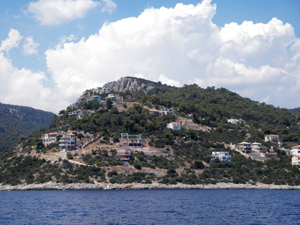 |
|
We followed the coast down towards Poros and into a little creek not far from the town. It looked really cosy, but when we had anchored and had a swim it happened. We were attacked by wasps. The dash into the boat was as quick as lightning and the mosquito net went up just as quickly. We hoped that the wasps wouldn’t be early risers, as we moved out early the next day into the town. Luckily it turned out to be true. |
|
|
Poros |
|
|
Poros is counted as one of the Saronic islands but is situated very close to the Peloponnese. We got a good mooring on the north side of the guest quay and stayed for four days. We took the opportunity of taking the ferry to Athens to do some sightseeing. This picture is taken early in the morning from the ferry.
|
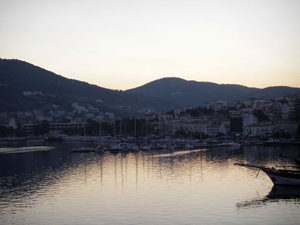 |
|
The actual town of Poros is very much like Gullholmen on the Swedish west coast with its’ closely built houses.
|
 |
|
It is a popular spot for charter boats and there is a huge turnover during high season. All different kinds of nationalities mix here.
|
 |
|
There are several anchorages around the island and this one is called “Russian Bay”. On the beach there is a ruin of a temple thought to be the temple of Poseidon.
|
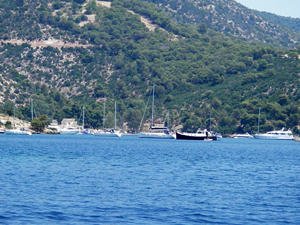 |
|
The ferry stopped at Aigina for an exchange of passengers before we carried on towards Athens.
|
 |
|
Athens |
|
|
This is our first impression of Athens – a huge city with a population of over 3 million people. The harbour called Pireus is enormous, which we noticed by the large number of merchant ships both in- and outside of the port.
|
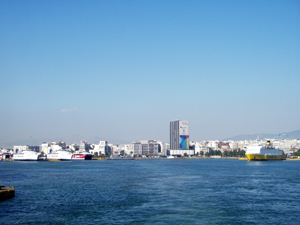 |
|
Our goal was to get to the Acropolis and find our way back in time to catch the last ferry to Poros around 18.00. But how were we to get there? We enquired and got instructions how to get to the Metro. We were also asked not to throw cigarette ends, as they could quite easily start a fire. (No chance of that on our part.) |
|
|
It was easy to get to the Acropolis on the Metro. A thought entered my head. What if there is an earth quake?” Well, there wasn’t one. Phew! |
|
|
The day was hot, but not actually boiling hot. Athens is built in a valley with mountains on three sides and the sea on the fourth. Here is Herod’s Atticus Theatre in the foreground, and as you can see from the modern chairs on the stage, it is also used today.
|
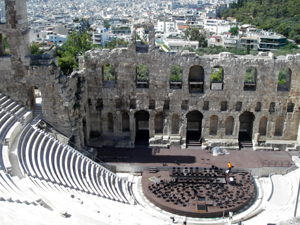 |
|
6000 years ago Athens was inhabited by the Pelasgians and later by people from the Ionian Islands, who discovered the Acropolis cliff at the height of 156m. Later, as the site grew, it was named after Athina, the Goddess of Wisdom. Different entities ruled up until the Greek liberation from the Turks 1834, when Athens was pronounced the capital. In the background Lycabettus Hill.
|
 |
|
In the picture “The Parthenon”, the temple of the virgin Athena. (Parthena = virgin in Greek.) It took 15 years to build between 447 – 432 B.C. Today the site is swarming with tourists with their cameras. We heard one tourist guide say that 70% of today’s Greek language is the same as the one spoken in ancient times. A lot of renovating work is going on and you can see scaffolding everywhere. Somebody said that now they are renovating previous renovation work…
|
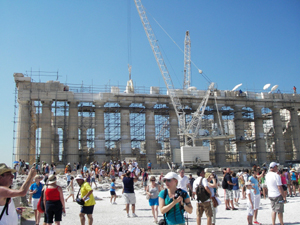 |
|
Here we are in front of the “Erechtheio”, which is supported by the magnificent “Caryatids” – young priestesses supporting the temple’s roof with their heads. The temple was dedicated to the mythical hero king Erechtheus, who was later identified as Poseidon. It was told that Poseidon and Athina were competing about who was going to protect Athens. Athina won by producing an olive tree from the earth.
|
 |
|
More picture in the Gallery. |
|
|
It was a fantastic experience to have been to the Acropolis, despite the crowds and the heat. We rounded off our visit to Athens with a tasty lunch and a stroll in the market before we made tracks back to the ferry. Later in the summer we read about the great fires in Athens...
|
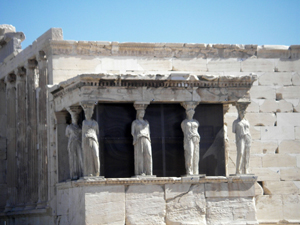 |
|
Bay: 37o 21,99´ N och 23o 13,97´E |
|
|
The leg from Poros to this bay took four hours – and we had the engine on as there was no wind. Characteristic for this island – in our point of view – was how green it was.
|
 |
|
The heat was really getting to us by now. It was about +36o C in the shade. Now our cleverly designed wind scoop was going to be very handy. We thought up a fantastic creation in Malta. There is only one problem with it – it doesn’t work very well |
 |
|
As we had some parachute silk left I decided to make another one. It was quite therapeutic sitting in the quiet, stitching by hand. The end result isn’t too bad. And the best thing of all – this construction works!
|
 |
|
We always check oil, etc. before we start the engine and this time we discovered quite a lot of water in the engine room and the bilges. Whatever could it be now? After a thorough examination of everything we discovered that the gasket for the salt water pump was broken. And we didn’t have another one… |
|
|
We couldn’t carry on with a leaking water pump. We would get water in the boat and the engine would overheat. We had to find something we could use as a gasket. We tried all sorts of things: paper, carton, oil cloth. Nothing worked. Every time we took everything apart to try it. Finally we tried a piece of my rubber band I use for training. This time it worked! We felt quite pleased with ourselves. Now we would make our way to Porto Heli, where we knew there would be a ships chandler.
|
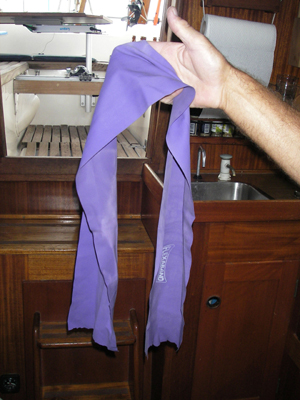 |
|
Porto Heli |
|
|
No wind, so we used the engine again. For three hours. We were quite nervous and checked the engine room all the time, but everything seemed fine. |
|
|
We were shown to a little boat yard where you could order parts from Athens. We decided to get new parts for the whole pump. It would take a while before they would come. I took a picture of their cosy staff room.
|
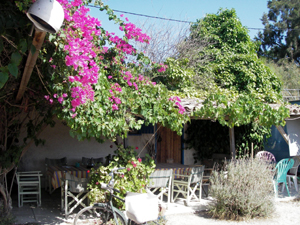 |
|
We knew that John and Amber were at Nafplio, furthest in, in the bay of Argolikos Kolpos and decided to sail there. There was going to be some wind. |
|
|
Nafplio |
|
|
We were tacking for four hours before the wind changed and we got a good broad reach. It was lovely to be sailing! We moored behind the “Kings Ransom”, John and Amber’s boat. It was nice to to catch up on our adventures since the last time we met. They went south of the Peloponnese whereas we went the other way. We heard some hair raising stories…
|
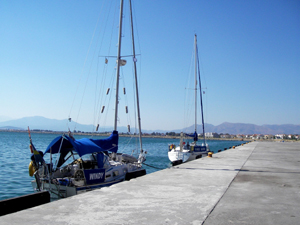 |
|
Nafplio has also got an eventful history with a lot of rulers. What I found most interesting was that Nafplio was the new Greek capital from 1828 to 1834, when it was changed to Athens. At the top of the mountain, with a view over the town, is the fort Palamidi.
|
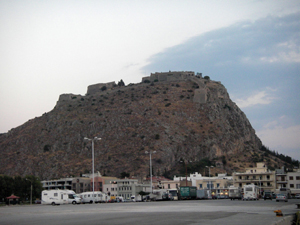 |
|
There are steps all the way up and if you count them you’ll find 857. You could certainly feel it in your legs when reaching the top.
|
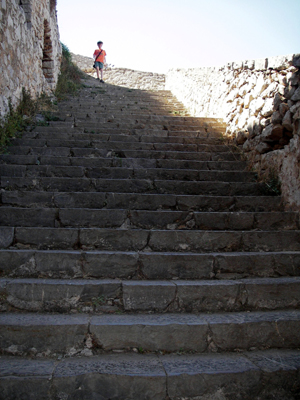 |
|
On the way up we enjoyed fantastic views over the area. You can see the fort Bourtzi on the island at the harbour entrance.
Here a few more pictures of the view.
|
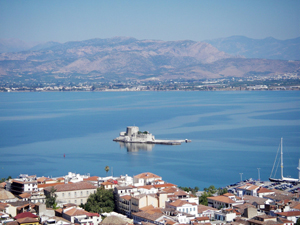 |
|
|
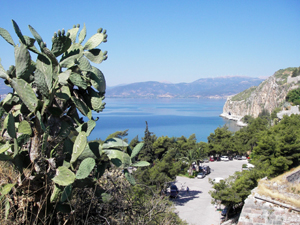 |
|
It was very hot now and this is what the grass looked like now.
|
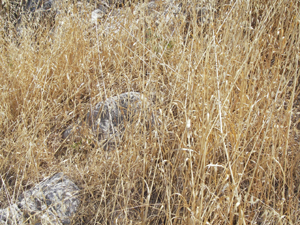 |
|
There was a dungeon in the fort and you had to crawl to get in there. I couldn’t get out quick enough – quite claustrophobic. You wouldn’t survive for long in there. It was easier to get down the steps, but it was hard on the knees.
|
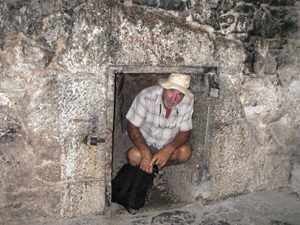 |
|
We hired a car for two days as there were two places we wanted to explore: Epidaurus and Olympia. The charge wasn’t too bad: €67. |
|
|
Epidaurus |
|
|
Epidauros lies 30km north east of Nafplio. It is an experience to drive a car in Greece! You need eyes at the back of your head… Epidaurus is a sanctuary from 600 B.C. and dedicated to Asklepios, the God of Medicine, and was a medical centre where pilgrims went to get treatment and advice. In the museum we saw some of the instruments used. Quite amazing!
|
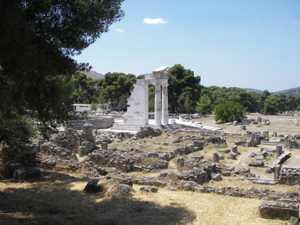 |
|
The ancient amphitheatre is world famous as it is the best preserved one in Greece. Even today you can attend performances where the acoustics are so good that a whisper can be heard at the top of the auditorium. 14 000 spectators can enjoy a performance at the same time.
|
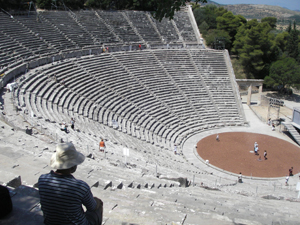 |
|
As we were walking around and looking at stone, as Mike says, we bumped into Jim and Daphne from the boat Quintessence. We first met them in Malta and it was nice to see them again. They were also moored at Nafplio, but had caught the bus up.
|
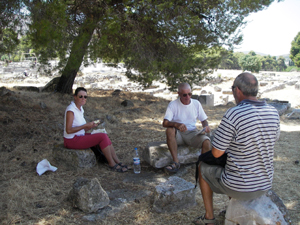 |
|
On the way back we went shopping at Lidl, the favorite shop for all sailors. Now that we had a car we could load it up with all the heavy stuff like water, milk, etc. |
|
|
Olympia |
|
|
It would take us about six hours to get to Olympia, so we set off early in the morning. The roads varied from narrow roads to motorway. On the motorway we paid a toll charge of €2,70. When we got up to the mountains they looked like this. On the picture you can also see the village of Langadia.
|
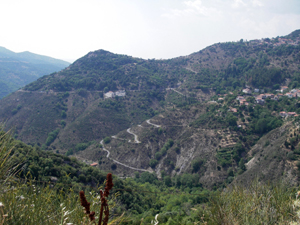 |
|
In Langadia we stopped for a cup of coffee. The terrace is hanging over the cliff and I thought that it would probably stay put until we had finished our coffees.
|
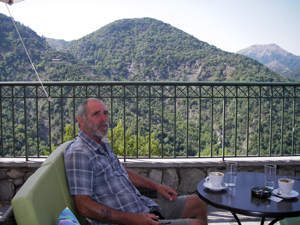 |
|
We carried on with our journey. Suddenly there was a hold up and a queue was forming. There was a house transport! It took a while for them to navigate a bend. Soon the traffic was flowing again.
|
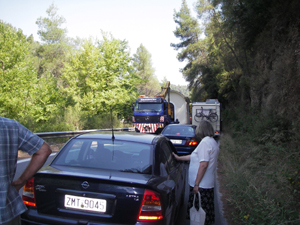 |
|
When we arrived we asked a taxi driver where the car park was and he just directed us to the side of the road. Strange, we thought, and parked some way away from the entrance.
|
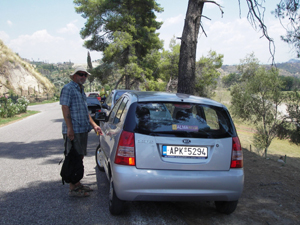 |
|
We started with the museum to gain more knowledge about what we were about to see. It was also very hot outside, so we took the opportunity of staying in the air conditioned rooms. There we found, amongst other things, Praxiteles’ statue of Hermes (330 B.C.). Every time I see these statues I am filled with wonder about the skill of the craftsmen creating something so life like. The object is, after all, made out of stone – quite incredible.
|
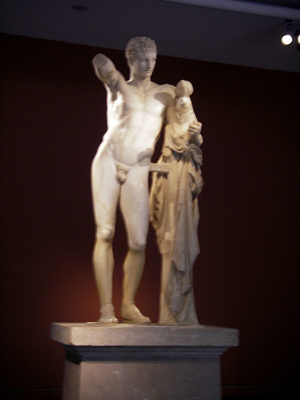 |
|
There are indications that already by 1000 B.C., games were being held here. They were held in honour of Hippodameia, King Oinomaus daughter, and her husband Pelos. The games were exclusively local at the beginning, and gradually attracted the interest of the other towns in the vicinity. In 776 B.C., the leader of the Eleians, Iphitos, rededicated the games to Zeus. This date marks the first Olympiad, after which they were held every four years. Athletes from all the Greek city-states were welcome and a truce was declared during the games. The victor’s prize was a crown made from a wild olive branch, which was always cut from the same tree, the Kallistefano.
|
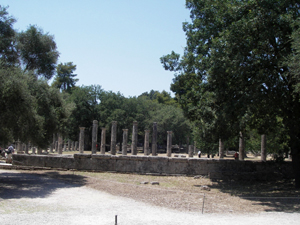 |
|
The games consisted of the usual athletic events plus artistic and literary contests up until 393 A.D., when Theodosius I prohibited the games.
|
 |
|
In 1896, they were revived where they had been born, in Greece, by the French historian and educator Pierre de Coubertin. The games have taken place every four years since then and the Olympic fire has been collected from Olympia in Greece. Here a picture of the Olympic village that took care of all the participants.
|
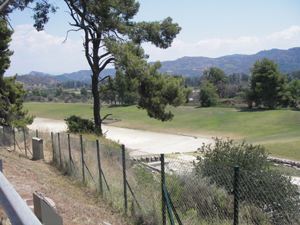 |
|
This is the “tunnel” to the Stadium where all the athletes went through. One could feel the historic atmosphere…
|
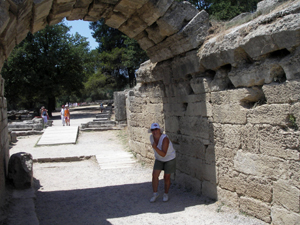 |
|
Talking about atmosphere we decided to sit down in the shade of some trees to have a rest. There we heard, as we often did, the sound of cicadas. They sound a little like grasshoppers, but it is a continuous sound. If you want to listen to it you can find it at this address: http://en.wikipedia.org/wiki/cicada Click on “Cicadas in Greece” We have tried to see one for ages but we didn’t count on taking a picture of one. Suddenly I saw one on the trunk of the tree. I took a picture and didn’t think anything would come of it. I was very pleased to see the result.
|
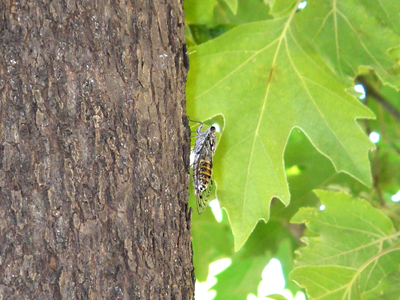 |
|
Now it was time to make the journey back and we had six hours ahead of us. On the winding road in the mountains we met a lorry. We had just passed a bend and had to reverse back as there was more space to pass each other. We were on the outside lane and there were no barriers. Was nervous?! Guess!
|
 |
|
With a clear conscience we returned the car without any bumps or scratches. Jim and Daphne were hiring it next. The next morning we set off on Windy again. |
|
|
Kiveri |
|
|
On the other side of the bay there is a little village called Kiveri. We swung on the anchor over night, but left the next day as it was most uncomfortable. |
|
|
Kokkani |
|
|
In the morning we hoisted our sails and had a wonderful passage to the Kokkani Bay, just below Kranidi. We only stayed the night as we had said that we were going to collect the parts for the engine the following day.
|
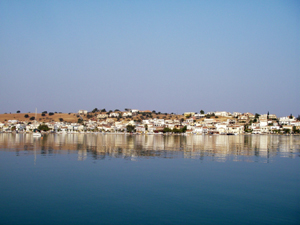 |
|
Porto Heli |
|
|
Well, we were back again. The parts had arrived and it felt good to collect them. We were swinging out in the bay and intended to take the dinghy in. It was quite a distance in to town so we thought we might as well use our new outboard engine. But it was leaking petrol everywhere! We had to take the engine apart to find out what was wrong. We took the tank out and could see that the flange was hanging there by a thread. We had to row in and get a new petrol tank – which had to be ordered from Athens. And it would take some days to get there. So we ordered one, weighed anchor and went back to the Kokkani Bay.
|
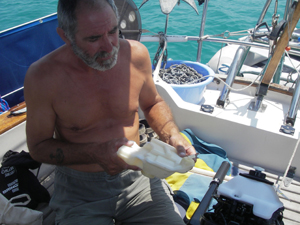 |
|
Kokkani |
|
|
This bay is delightful. The anchor doesn’t budge, it is quiet and no disco-music. Now and then the big Careta Careta turtles swam by. Mike changed all the parts in the salt water pump, and we could almost hear the engine say “Aaah!” We did actually sense a difference in the effect of the engine. After four days cleaning and polishing the boat, we left for Porto Heli again. |
|
|
Porto Heli |
|
|
We picked up the new petrol tank for the outboard, which now is working as it should. Nothing more can happen to our engines now…. can it? |
|
|
We were waiting for the Meltemi (the prevailing north easterly wind) to abate so that we could have a comfortable crossing to Milos in the Aegean sea. A passage taking about 14 hours. One day we saw Jim and Daphne “limping” in with their boat Quintessence. They couldn’t use their propeller at all. In the protected harbour of Porto Heli, Jim had to “push-tow” their boat with the dinghy. They anchored not far from us. |
|
|
After contacting various places they finally booked a place at the boat yard in Kokkani. The only way they could get there was to sail. For this they needed quite a lot of wind as their boat is big and heavy. We offered to go with them as an escort boat in case something should happen. Now we found out how real professionals weighed anchor under sail. It was a beautiful sight. |
|
|
Kokkani |
|
|
We got enough wind alright! The wind was peaking 33 knots, but everything went well and we were back at Kokkani. In the evening we were invited round for dinner on Quintessence. We thank you for a most enjoyable evening.
|
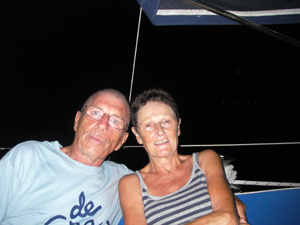 |
|
The next evening we were invited round to Kerstin and Göran’s boat, s/y Kyoung Sook, for an exchange of books and experiences. Thank you for a pleasant time and for a nice G&T.
|
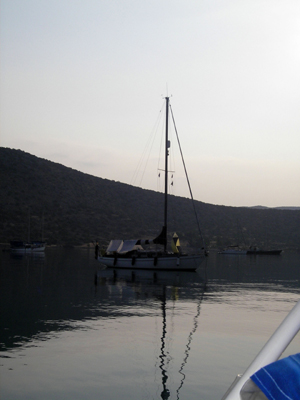 |
|
As we left in the morning we took this picture of Quintessence.
|
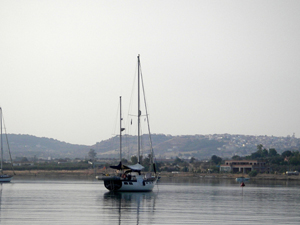 |
|
Porto Heli |
|
|
We are beginning to know this route by now! We only stayed one day to stock up for the trip over to Milos in the Aegean. |
|
|
The Aegean Sea – Cyclades |
|
|
On the 3rd August we weighed anchor in the afternoon. We planned a night sail so that we would arrive at Milos in daylight. I looked forward to my night watch and was hoping for similar experiences as in the Ionian Sea. |
|
|
The Meltemi had been blowing hard for several days and the waves were big, but now we didn’t have any wind and were motoring. We were corkscrewing forward. It was like this all night. It seemed as if all the cruising ships and merchant ships of the whole of Greece were out. We had to watch out that we didn’t get in their way. By the time we reached Milos we were exhausted. Many a time during the night we helped each other to interpret radar and different navigation lights. It was 05.50 when we anchored and had our breakfast. Then some pounding disco music, played over loud speakers, bellowed across the bay. We wondered if this was really happening. After breakfast we weighed anchor again and went looking for a quieter place. The sea was like a mirror now.
|
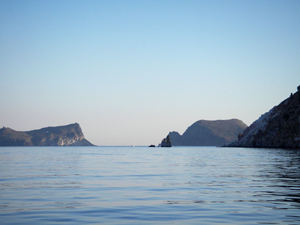 |
|
At 09.40 we found a bay on an island north of Milos called Kimolos where we anchored. We were really tired by now and went to bed. Then we heard a donkey on the beach … Iiiiioooooh! Iiiiiioooh! Eventually we fell asleep. |
|
|
Next morning we set off towards the island of Thira, or as it is also called Santorini. First we passed this little rocky island north of Milos. The passage to Santorini took just over 10 hours.
|
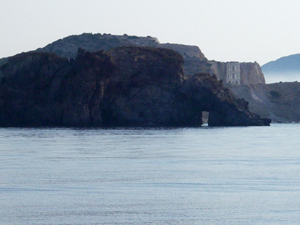 |
|
We had been out for a while when the mist came down. My nightmare has always been to end up in fog. Not being able to see what’s out there. The radar is a Godsend (glad we bought one). So there we were with our ears pricked and eyes glued to the radar. It didn’t clear up until the afternoon |
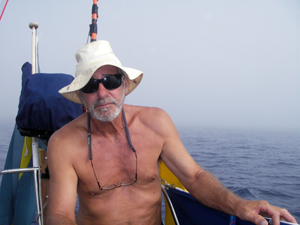 |
|
Santorini |
|
|
As we approached Santorini it looked like snow on the mountain tops. But as we got closer we saw that it was buildings. It was an awesome feeling sailing into a volcano.
|
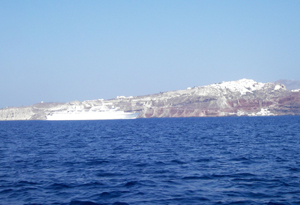 |
|
Several thousand years ago there was an island that – according to Herodotos – was called Strongili (the round one) in the Aegean sea. On top of this island there was a volcano, which was active periodically. The largest eruption happened around 1650 B.C. Strongili broke up and part of the island sunk into the sea. What was left was Santorini, the island Therasia and the uninhabited island of Aspronisi. The cavity filled up with seawater and the basin created is internationally called a “caldera”. In the middle of this caldera there are the two small islands of Palia and Nea Kamina formed at a later time. According to different theories/explorations there was a huge tsunami 10m high swamping the northern part of Crete.
|
 |
|
It was evening and we were motoring around the caldera trying to find an anchorage. We went to Fira (the capital), but didn’t find a safe place there. Here we saw huge cruising ships waiting for their passengers to return from their sightseeing trips. They move during the night to other places of interest - as we know!
|
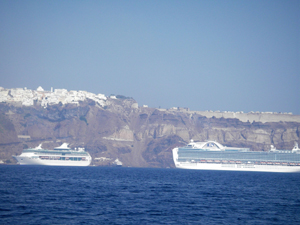 |
|
We passed Nea Kamina with its’ black glistening volcanic rock.
|
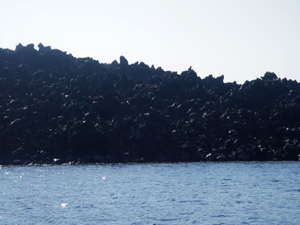 |
|
The caldera stretches over 82,5 km2 and we were beginning to get nervous as we moved from one anchorage to another without finding a space. The walls of the caldera descend straight down to the sea and the depth is about 300 – 390 m. Our anchor chain is 50 m… At long last we moored to a buoy by the village of Ia. A relief as it started to get dark.
|
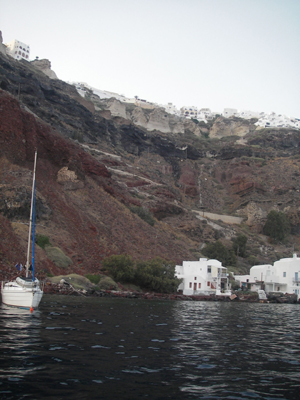 |
|
We only stayed the night, and then we carried on to Vlikadha on the outside of the island the next day. The picture shows a cross section of the ground and you can clearly see the different layers of soil. The top layers consist of pumice stone and theraic soil (ash) and can be 40 m thick. The estimation is that more than 2 million tons of pumice and theraic soil was exported every year until recently. Now the economy consists of tourism. There is an elderly couple with a dog living at the bottom of the cliff wall. They don’t seem bothered about any future landslides…
|
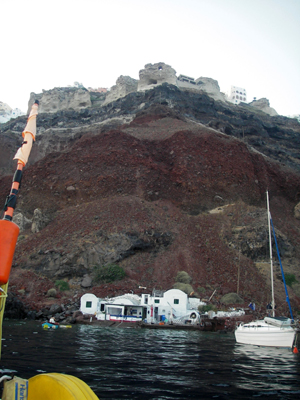 |
|
Before all the light disappeared we saw this Gulet glide into the caldera.
|
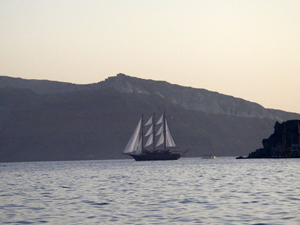 |
|
…later the moon rose over Santorini.
|
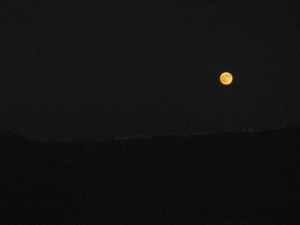 |
|
It took us two hours to get to Vlikhada marina from the northen side of the caldera. It was the most hair raising leg so far! 3m high waves rolling in from the side, which made us roll too. Once we arrived into the calm marina we had access to electricity, water and internet. We got a nice berth. Picture taken at a later time.
|
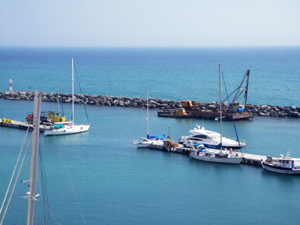 |
|
We took the opportunity to do our washing. It is not the actual washing that uses a lot of water – but the rinsing. Couldn’t resist to take this picture later when out for a walk.
|
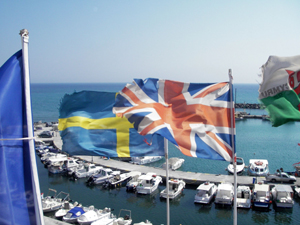 |
|
The following day we missed the bus to the next town, which should be about 3km away. Ah well, we thought, and decided to walk there. It must have been more like 10km! On the way we passed this unfinished house. We have seen these before.
|
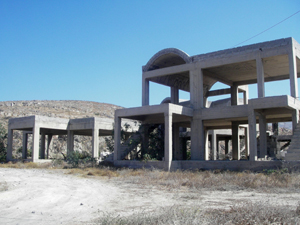 |
|
We also passed vines. But that’s not what they look like? Yes, they do here. The people of Santorini have always pruned their vines very hard and they also tie the stems with cloth to protect them from the wind. The vineyards are famous and produce the following wines: Brousko, Nichteri, Malavazia, Visanto and the sweet Mezzo.
|
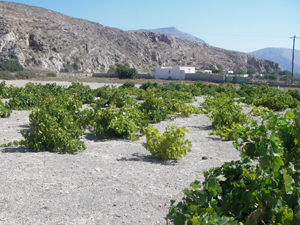 |
|
After we had done our shopping we stood by the road side and watched the bus go by. We started to walk. After a while a car stopped and asked us if we were on our way to Vlikadha? A great sigh of relief! Did we really walk this far? |
|
|
The next day we caught the bus to Thira to do some sightseeing. There were little alley ways everywhere with shops selling all sorts of things. Tourist goods, as we say…
|
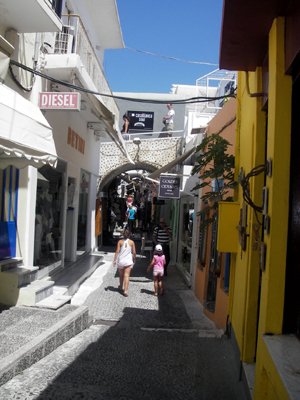 |
|
We took the cable car down instead of riding on a donkey. The path zigzagged up the hill where people and donkeys were struggling both ways.
|
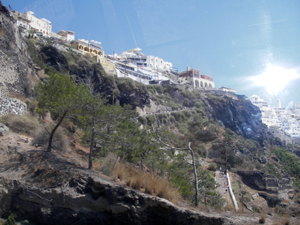 |
|
A picture of the harbour.
|
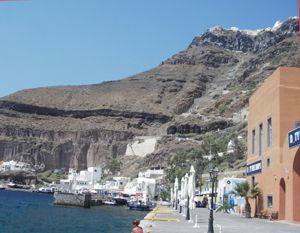 |
|
The view of the caldera is breath taking |
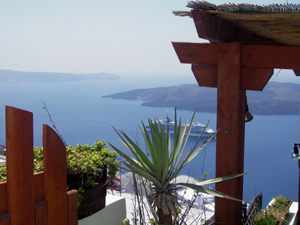 |
|
The archeological museum in Thira is well worth a visit and displays many of the artifacts found on the historical sites. Thank you Daphne for the tip. |
|
|
Apart from wine they also produce Fava, which is a traditional dish made out of a kind of peas grown on the island. Tomatoes were cultivated from the 1920s. They are quite small, but very tasty. The white aubergine/eggplant is also typical for the island. We are testing a lot of, for us, new vegetables and experiment with our food. Tasty!
|
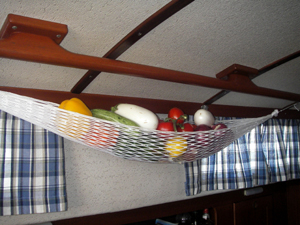 |
|
When we were inside the caldera we saw this cloud forming in front of our eyes. Fascinating. It wasn’t rain coming down from the cloud – it was moisture going up into the cloud.
|
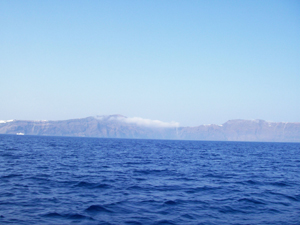 |
|
We stayed eight days on Santorini waiting for the Meltemi to abate so that we could carry on. When we got our weather window at last, we hade a lovely sail to Astypalea which took 12 hours. |
|
|
Astypalaea |
|
|
This is one of the twelve islands called The Dodecanese and lies nearest to the Cyclades. The island is known for its’ beaches and for its’ big Festival on the 15th August dedicated to “The Day of Our Lady’s Assumption”. We were here on the 14th and decided to carry on towards Kos the next day. The forecast was that the wind would increase again on the 16th.
|
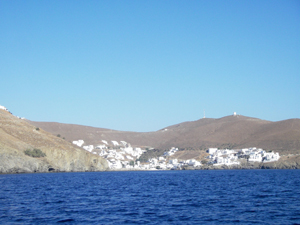 |
|
Kos |
|
|
We had quite a lot of wind coming exactly from the right direction, i.e. north east. So we were close reaching on the port tack with Bft 6-7. The waves were about 2-3 m high. (I was OK once I had got used to the movement of the boat.) The passage took 7 ½ hours. For some of the way a big dolphin accompanied us – just as fascinating as always. |
|
|
We didn’t go to the big tourist resort of Kos on the other side, as we planned to travel along the Dodecanese islands down to Rhodes. Apart from anything, Mike felt that he had seen enough of stone to last for a while. But what is interesting is that Kos is known to be the birthplace of Hippocrates, the father of medicine. There are a lot of things to look at. |
|
|
In Astypalea we noticed splashes of oil in the engine room. As there was good wind we decided to get to Kos all the same before further investigations. Now the fault finding started. In the end we could state the following: the bolt through the propeller shaft had sheared in two places. The propeller shaft is connected to the gear box and the bolt keeps everything in place and this is where the oil was coming from. A lot of different thoughts were whirring around in the head… We went to the village, got new bolts and fixed the problem. Saw this nice pomegranate tree on the way
|
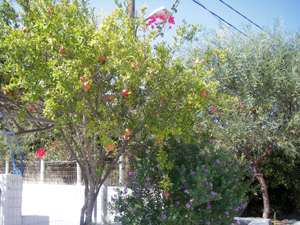 |
|
Nothing more can happen to our engine now…. can it? |
|
|
Tilos |
|
|
We were getting closer to Rhodes and decided to go to the island of Tilos 40 NM away. We planned to stay for quite a while, before meeting up with our daughter Sarah, who was going on holiday to Rhodes. The island looked quite barren as we approached.
|
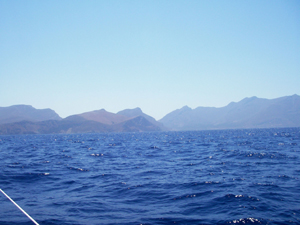 |
|
But the actual village of Livhadi was clean and beautiful with its’ planted trees and flowers. The harbour was small, but we managed to find a space. As we said, it has its’ advantages to be small.
|
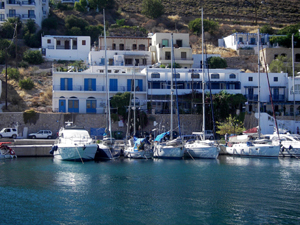 |
|
The water was crystal clear…
|
 |
|
… and we went swimming along the long beach, which consisted not of sand but pebbles. Our swimming shoes came in very handy.
|
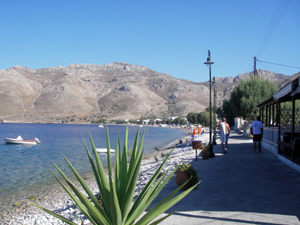 |
|
Fantastic hibiscus plantations adorned the beach promenade.
|
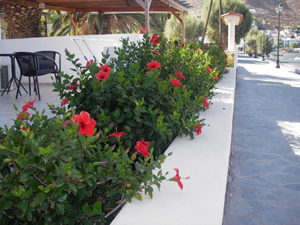 |
|
In the square there were outdoor restaurants where you could sit in the cool of the evening and have a nice meal and a drink. |
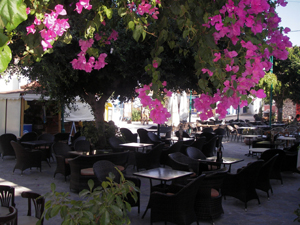 |
|
One day the doctors’ surgery came into the harbour and we saw many locals going in…
|
 |
|
This is a place we would like to return to one day. |
|
|
Rhodes |
|
|
The passage from Tilos to the town of Rhodes was windy, to say the least. Reefed sails. It is windy most of the time on the peninsula, which the tourists appreciate as it would otherwise be unbearably hot. We went into the Mandraki marina. The places that were empty were reserved, so we carried on to find somewhere else to stay.
|
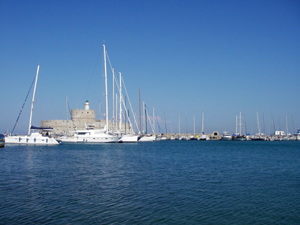 |
|
The next bay Limin Emborikos was reserved for big motor cruisers and sailingboats, so we carried on to Limin Akandia. Furthest in there was shallower water where the big cruise ships couldn’t go, where we got a good anchorage. Just as well, as the wind increased during the week we stayed there. Believe it or not – in this bay I was popping seasick pills!
|
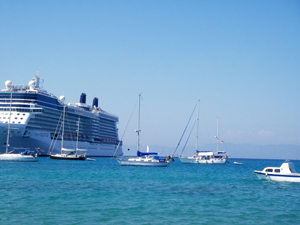 |
|
There is a marina under construction called the Rhodes Marina. Today it consists of a breakwater. When we asked when it would be finished the answer was: “Gods know! It has been under construction for 10 years!”
|
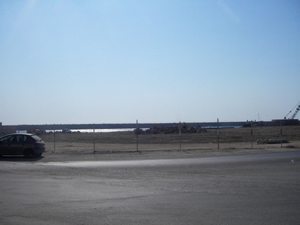 |
|
It was nice to meet up with Sarah and her friend Therese who were holidaying here.
|
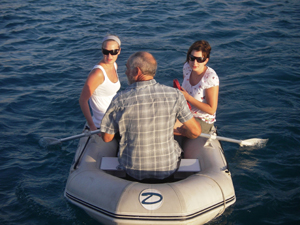 |
|
Personally we prefer more secluded places… perhaps we are getting old?
|
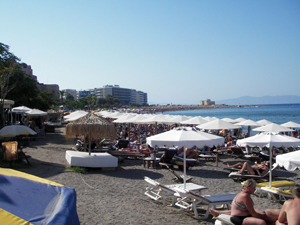 |
|
On Rhodes there’s a lot of stone to look at, if you so wish. We chose to stroll around the “Old Town” and walk around the harbour area. The town was vey tourist orientated with everything that entails.
|
 |
|
It has been told that a giant monument was created, over 30m high, depicting the sun God Helios, straddled over the harbour entrance. There are many theories about its’ existence and where it would have been situated. It would have been finished 282 B.C. and taken 12 years to construct. It disappeared without trace, but there are testimonies from people who claim that they have seen it.
|
 |
|
Today two bronze statues of deer adorn either side of the harbour entrance.
|
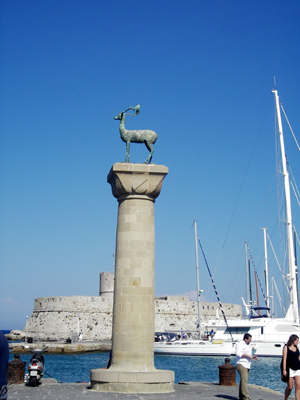 |
|
The history has been eventful as everywhere in the area. 1291 The Knights of St. John came to Rhodes and ruled for 200 years. The Grand Master’s palace is a magnificent building withstanding the ravages of time. As we know the Knights ended up in Malta eventually…
|
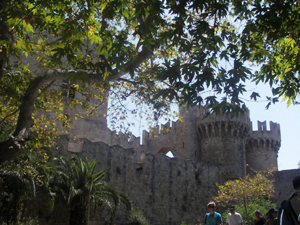 |
|
The walls around the town had a perimeter of 4 km and had seven portals.
|
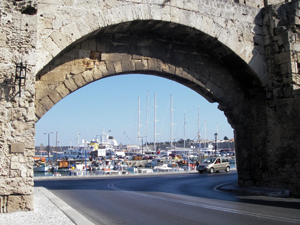 |
|
It was very hot and we stopped frequently to top up with liquid. The hibiscus tree flowered beautifully.
|
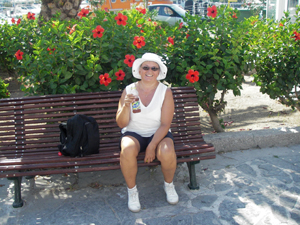 |
|
We decided to construct a new shower and bought a pressure pump in a garden centre. With a shower head it works perfectly.
|
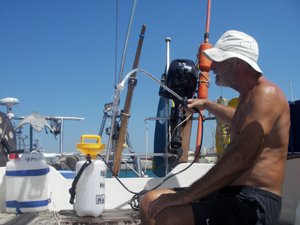 |
|
We waved goodbye to the girls who flew back to Sweden, and we set off towards Lindos. |
|
|
Lindos |
|
|
We stayed in Lindos for nine days and had a “holiday”. The whole place was very calm and later we heard it being called “The Quiet Bay”. According to mythology it was Lindos, the grandson of the sun god Helios, who colonized the place. Hence the name. St. Paul is also said to have visited Lindos at 57 A.D.
|
 |
|
The predominant fort was built during the time of the Knights and was used for administrative and judicial purposes. 12 Knights resided here. Between the houses there are narrow alleys, where tourists and donkeys are jostling for space.
|
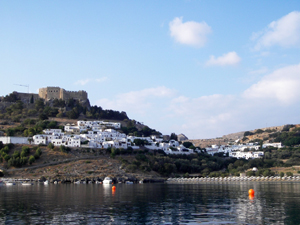 |
|
The alleys are paved with pebbles, stood on end, making nice patterns. Beautiful, but very slippery.
|
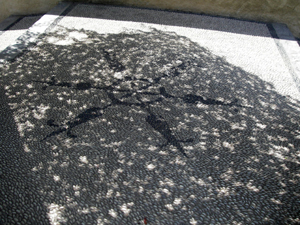 |
|
It was now time to cross over to Turkey. But first we stayed one night in Rhodes and anchored in the same bay as before. |
|
|
Turkey |
|
|
We had a nice sail over to Turkey and Marmaris, which was a Port of Entry. It was noticeable how clean everything was and that things were in good order and working, not least the nice showers. We had to walk back and forth between different authorities to get a transit log and our documents stamped. The currency was now Lira and not Euro anymore. As soon as we got our documents in order we carried on with our journey. We will return to Marmaris next year and write more about it later. |
|
|
The difference in the landscape, compared to the Cyklades, is the greenery. The green hills rolled down to the waterfront by our anchorage. The Gulet-ships became our neighbours. This is a nice way for tourists to get a sailing experience whilst being on holiday.
|
 |
|
The light green bushy trees are pine trees with very long pines. The tree is called Pinus Halepensis, and is spread all over the Mediterranean. It grows wild and is also planted as a wind shelter and for binding the soil. It also grows in the mountains and is connected to the Goddess of Rhea, who according to Greek mythology, was the daughter of Uranos and mother of Zeus. It is therefore considered a link between heaven and earth. The resin is used for making wine which has a bitter taste of turpentine. It is called retsina. There was also a donkey on the beach. He didn’t make a lot of noise…
|
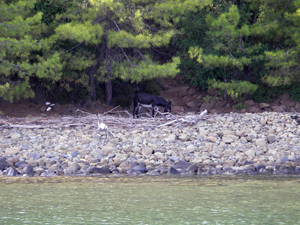 |
|
All of a sudden we hear people on the Gulet shouting “Windy, Windy!!!” One of our mattresses we had laid out to air had blown into the sea and was floating towards the beach. When I popped my head out of the cabin Mike told me: “Your mattress has blown away and is floating towards the beach”. What does he mean my mattress??!! They are exactly the same. Anyway we retrieved it and it dried quickly in the sun. Now my mattress was rinsed, fresh and very nice.
|
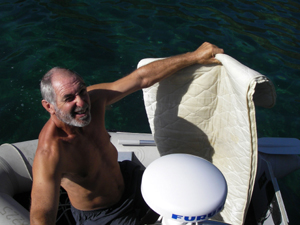 |
|
Our next stop was Fethiye, which is also a Port of Entry and larger town. We stocked up with food and supplies before we carried on. The camera took a break here as well |
|
|
To get to our next anchorage in a bay we had to either go round or go between some rocks. When we saw that the cardinal buoy actually was standing on the rock and not in the water, we decided to go around. The picture is unclear as it was taken some distance away and zoomed in. We stayed well clear.
|
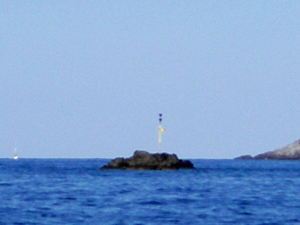 |
|
The harbour in Kas was tiny and it was a bit chaotic when everybody wanted to get in, big as well as small. We all helped each other and it worked out well.
|
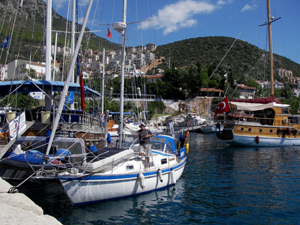 |
|
The town looked new and fresh. We saw many houses like this.
|
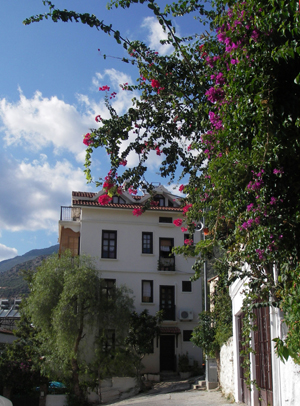 |
|
Simena and the Ücagiz-bay |
|
|
As a contrast we saw this house in Simena opposite the Kekkova island.
|
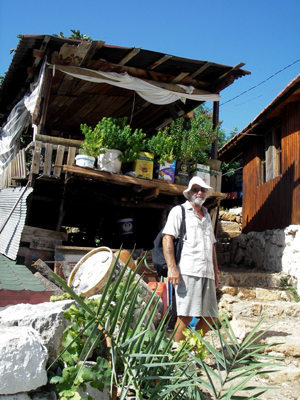 |
|
Behind the Kekkova island there is a beautiful bay off the mainland where the little village of Ücagiz and the old ruined settlement of Theimussa, with its’ well preserved tombs, is.
|
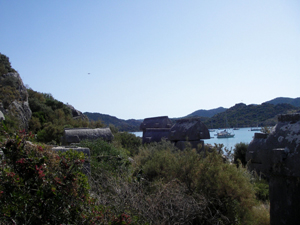 |
|
There isn’t much found to date Theimussa, but some inscriptions on the tombs have been dated to 4th century B.C. The land began to sink and as a consequence many of the ruins are under water.
|
 |
|
We climbed over the knoll to the other side where the village of Simena was. On the way there we saw many similar tombs. I am standing next to one so that you can see the size of them. It is amazing how they moved these enormous blocks of stone. In the background a very old and huge olive tree.
|
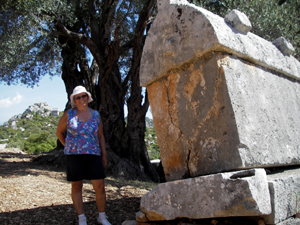 |
|
Simena is a small village where the inhabitants pursue fishing and tourism. Simena and Kekkova are known for being the “Sunken City” as there are ruins beneath the surface. We bought two frozen chicken filets here for TL7,25 ( 1TL = c:a 5 SEK or £0,40)
|
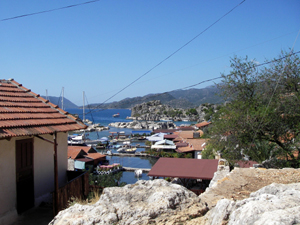 |
|
We stayed in this bay for six days swimming, reading and just relaxing.
|
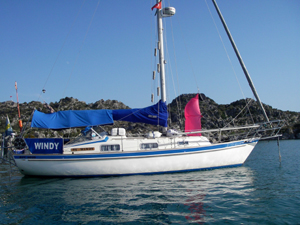 |
|
Finike |
|
|
The leg to Finike took 3hrs 20minutes and was just a short hop. |
|
|
We now felt quite ready for the winter stay. The size of the marina is just right and Finike isn’t a busy tourist resort. We had already booked our place and now paid the remaining fee, which in total meant €985 incl. of water, electricity and internet for seven months. |
|
|
The service house where the toilets/showers, launderette and washing facilities are, look very new and fresh. Next to this building there is a place where you can wash sails, etc. Brilliant!
|
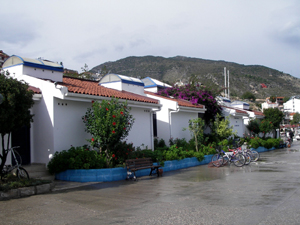 |
|
Place for washing sails. |
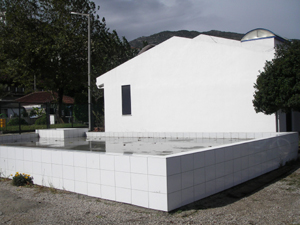 |
|
The sailors also have access to a clubhouse, The Porthole, where you can have different activities. There is a large book swop library as well.
|
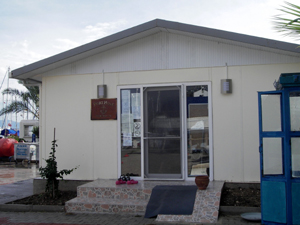 |
|
If you walk towards the town you pass Mustafa Kemal Atatürk Park, which has remarkable ficus trees and other exotic plants.
|
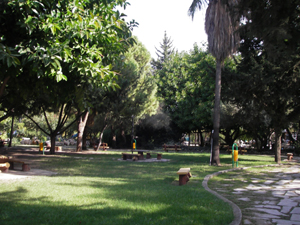 |
|
Finike is also known for its’ orange groves, which you can see on different signs and monuments. You have all heard of the "Big Apple"? Well this is the "Big Orange". |
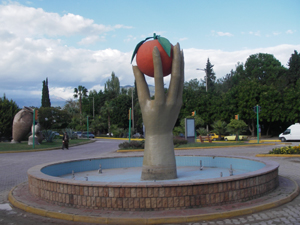 |
|
So our first impressions of Finike have been positive ones. More reports will follow. |
|
|
In conclusion |
|
|
The summer has been full of experiences and gaining knowledge. We have met a lot of people, sailors and others. We have definitely seen a lot of rocks! We have learnt a lot about historic places and cultures, thus gaining more understanding about different nationalities. |
|
|
We have also gained more insight about ourselves and what we can achieve. Not least due to the saga of our engine! After the repair in Kos it didn’t break down at all. It worked very well actually… |
|
|
Now I have peeped into some books about Turkey and the winter promises to be a very interesting one! |
|
|
Until next time: don’t worry – be happy! |
|
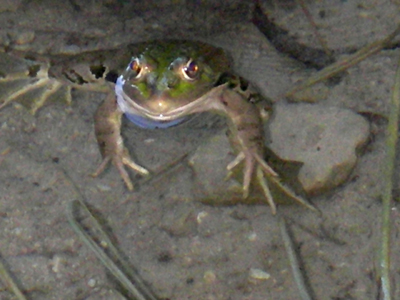 |
|
| I kissed Mike and look what happened!! | |
